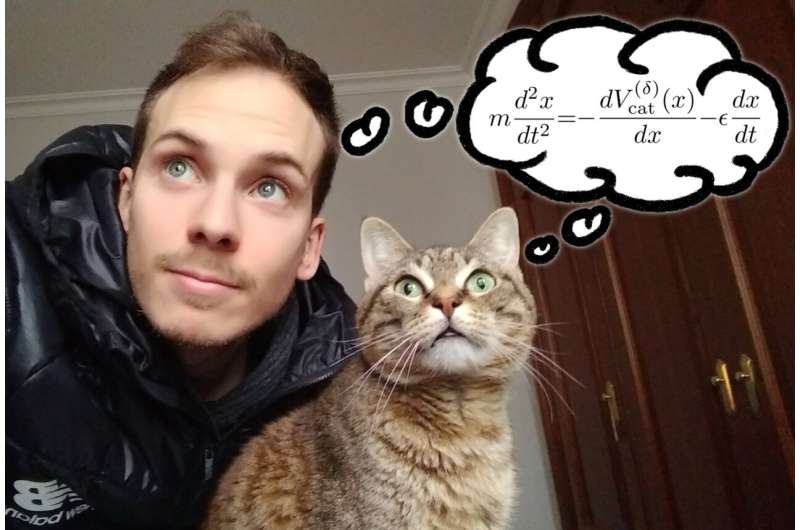
November 4, 2024 by Galician Institute of High Energy Physics
Collected at: https://phys.org/news/2024-10-physicist-cat-reveal-equation-motion.html
In the social media age, there is little doubt about who is the star of the animal kingdom. Cats rule the screens just as their cousins, the lions, rule the savanna. Thanks to Erwin Schrödinger, this feline also has a place of honor in the history of physics. And it was Eme the cat that inspired Anxo Biasi, researcher at the Instituto Galego de Física de Altas Enerxías (IGFAE), to publish an article in the American Journal of Physics.
In this paper, Anxo presents the equation of cat motion. “This article aims to bring physics closer to non-experts, offering a pleasant example through which it is possible to understand several concepts of classical mechanics. To do so, an equation is constructed that models the behavior of a cat in the presence of a person, considering the former as a point particle that moves in a potential induced by the human,” he summarizes.
Explaining physics with cats
Anxo recently joined the IGFAE, a joint center of the University of Santiago de Compostela (USC) and the regional government from Galicia (Spain), through the Junior Leader program of La Caixa, from the Physics Department of the École Normale Supérieure de Paris.
At the IGFAE, where he has already completed his doctoral thesis, he will develop his line of research in non-linear evolution equations, at the intersection between physics and mathematics, joining the String Theory and related fields team.
The idea for the article came about to “communicate physics in a fun way, making it more attractive to students,” he says. And so, what seemed, to some extent, a joke, gradually took on an academic form.
“This started as a playful idea for Fool’s Day, inspired by the funny papers presented by some researchers. However, I soon realized that this story I created could be of great help to physics students. The story is very conceptually loaded, but it introduces it in a fun way using an example that arouses great curiosity: a cat!”
And how is the equation of cat movement built?
Anxo starts from seven dynamics, or patterns, extracted from his day-to-day experience with Eme, and uses the hypothesis that “cats behave as if they perceive a force around a person.”
In this way, the article states that the seven dynamics aforementioned can be modeled, as a first approximation, by considering the cat as a point particle that obeys Newtonian mechanics.
The cat experiences a “force” linked to an external potential (induced by the presence of a person) where x(t) ∈ R represents the position of the cat at time t with respect to the person located at x = 0. Thus, m > 0 is the mass of the cat, and ϵ > 0 is the coefficient of friction to consider the cat’s fatigue. The result is, therefore, this equation:

Starting from this formula, and through the analysis of feline motion, it is possible to show how the equations themselves are constructed.
“The work demonstrates, in an entertaining way, the mental process followed in the construction of physics models, which is rarely detailed in books. For example, patterns of movement (or non-movement) are analyzed, derived from the fact that cats tend not to come when called, are easily distracted, or tend to stay longer on the lap of their favorite person.”
All these calculations are approached in an engaging and fun way. “We don’t always need to tackle the deepest and most challenging mysteries of the universe; sometimes we can just relax and use the power of physics to explain everyday life—it’s really funny!”, Anxo says.
In this way, “the cat-human interaction model brings physics closer to non-experts, demonstrating through a curious and familiar situation the reasoning behind the construction of physical models,” he summarizes.

Purring and zoomies analysis
The paper focuses on the analysis of the characteristic feline purr. His proposal is that this reaction is a stabilization mechanism, which is fed back by the interaction between the cat and its human companion.
“It is proposed that when a cat is being stroked and starts to purr, people tend to feel the impulse to continue stroking it, thus reinforcing the stability of the process.”
This stabilization is also reinforced by the fact that the exchange of affection between purring and stroking temporarily strengthens the bond between cat and human.
The study also considers periods of frenetic random activity, known as FRAP or “zoomies,” when cats move at full speed from one place to another, usually at night. The paper discusses how, in this case, the equation requires a random component to model these periods, built into the formula as an external “forcing.” This adds some randomness necessary to model these cat “outbursts,” which to some extent could be adjusted to the particularities of everyone.
Educational use
In addition to its playful approach, Anxo stresses that this article “is intended for use in introductory courses in classical mechanics, to demonstrate how apparently complex and unrelated behavior can be explained by simple laws.”
It does so by showing “a series of dynamics that are easy to visualize, reducing the need for abstraction,” and presents “an equation with different terms, covering the fundamentals of classical mechanics.”
More information: On cat–human interaction from the viewpoint of physics: An equation of motion, American Journal of Physics (2024). DOI: 10.1119/5.0158200
Journal information: American Journal of Physics

Leave a Reply